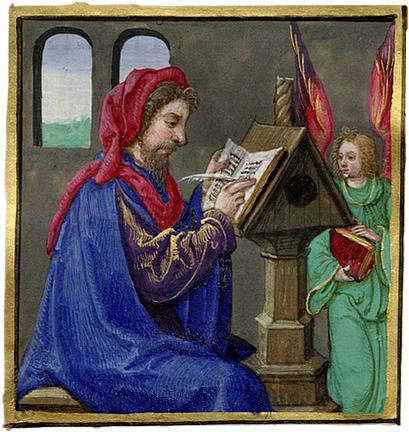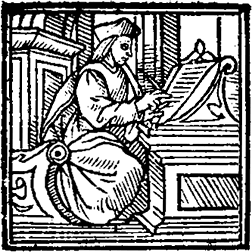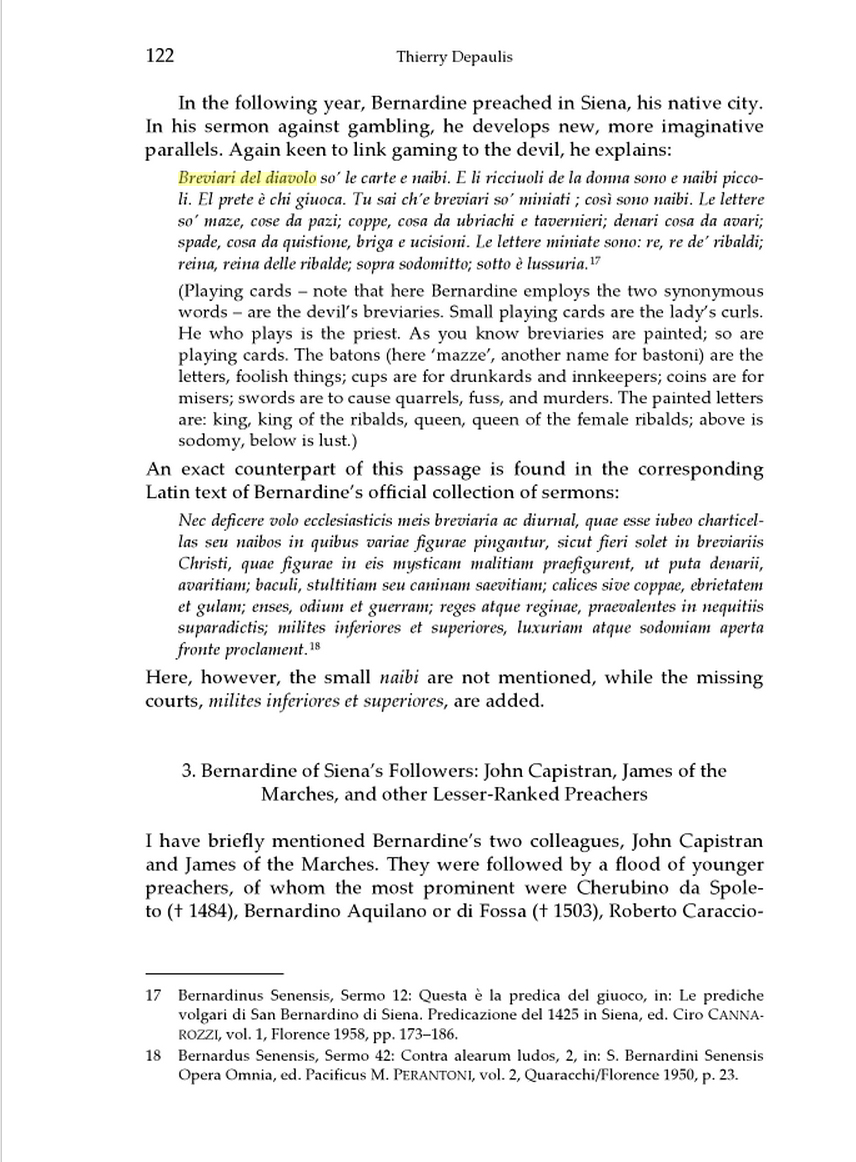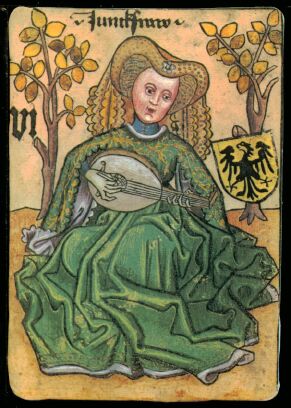Ross wrote,
I think you're confusing two things here - the iconographic sequence per se and the decorative iconography. The subjects of the Thunderbolt, Star, Moon and Sun (for example) are just that, and nothing else. The trump sequence needs no textual basis, however much the decorative iconography illustrating the main subject might refer to something outside of the sequence.
It seems to me that the "decorative iconography" might also point to an interpretation of the card within the sequence, beyond what is given by the card's title and the corresponding object in the card. Moreover, it would be natural for a player to look for such an interpretation, at a time when he or she is not actively playing.
Ross wrote,
For the playing part, I think players do in fact "shut out" the part not needed for play. In modern cards the indices do all the work, and few people can really name offhand any iconographic distinctions between, say, the King of Diamonds and the King of Hearts. Anyone who gets lost in the decorations on the cards during a game would probably get a slap and told to pay attention to the game.
I don't disagree. The player is not interpreting while he plays. If he asks himself what the card means, that is something he will put off for a lull in play, or after play, or perhaps it will something he asks or speculates about out loud during play as a way of distracting another player.
Ross wrote,
We have to assume that the game inventor wanted to make the sequence as easy as possible to remember, and left it to the artists to fill up the cards with distracting imagery. In some cases, like the Thunderbolt, the thing that the lightning is striking became the main or outstanding feature of the card, but it doesn't change the fact that the subject of the card, its "meaning" in the sequence, is a bolt of lightning, whatever it is striking and however it is portrayed.
This subject is what needs interpreting if we are trying to get inside the head of the inventor, the meaning of the subject in the context of its place in the sequence.
I have been trying to understand this without success. I don't understand why the game inventor couldn't want to make the sequence as easy as possible to remember and also want to subtly suggest an interpretation beyond what little is suggested by the subjects (titles and their objects), perhaps generalized from the particular context in which it appears in the text that inspired him or her, perhaps even more than one interpretation, assuming that some players will know the interpretive methods of Dante, Petrarch and Boccaccio. If so,the inventor will have the artist put clues in the details, in the context of details in nearby cards, for the player to reflect upon at his leisure. The inventor will also want to tell the artist enough that the artist won't put in details that go against the inventor's interpretation.
Then if a player, not then playing, wants to figure out what a sequence of cards meant to its inventor, and it wasn't obvious, it seems to me that the natural thing to do would be to look at the cards more closely for clues. In a church, if someone was looking at a sequence of saints and wondered if one of them was Bartholomew, they'd look for the knife. In a palace, if there was a frieze including a naked goddess (and entitled as such), a person would look to see what was with her, such as hounds or a naked little winged boy.
The only way he or she, and we, could get into the head of the inventor is by way of the cards and titles, i.e. specific cards in specific sequences in specific decks, bringing to them what a person then could bring. The subjects alone don't say much, even if it was known in what order they originally occurred. The "Angel" card clearly has to do with the afterlife. If "World" comes after "Angel", then maybe it does, too, although it's not obvious from looking at the A card.
So we have the subjects, words plus pictured objects: "World"--yes, there is something spherical there, a kind of globe. "Lightning" has lightning in it. And so on.
How could these words and corresponding objects alone convey the "Last Days" of the Bible, for any except the Angel card? Piscina and Anonymous didn't understand it, nor did anybody doing appropriati mention it, nor any literary source (not that these last said much at all). It's not obvious. And although he offered many interpretations (e.g. Manfreda), even Dummett might not have seen it--or, more likely, he declined it, given his refusal of the "hellmouth" interpretation of the Lightning card. All that one could get from the subjects of the the last seven of the early cards would be: two scary things, one supernatural and one natural with perhaps a supernatural cause; three celestials of increasing brightness; the raising of the dead; and a triumph, either having to do with a walled city or the material world, probably a triumph over it: so four spirituals and three celestials. The most conventional way of seeing the celestials would be as representing the passage of time. Whoever changed the title of the Temperance card to Fama probably thought that, thinking of Petrarch's sequence.
A player knows about trumping. Perhaps in this section he will find it a metaphor for a relationship between the subject trumping and the subject trumped. The Devil is stronger than Death. Lightning, as an instrument of God's power, is stronger than the Devil. The stars are more powerful than lightning, since lightning lasts but a second. The Moon is more powerful than the stars, being brighter. The Sun is more powerful than the Moon. The Last Judgment is more powerful than the Sun, since the Sun is extinguished at the end. If the World is more powerful than the Last Judgment, it must be something eternal as opposed to material. No reference to the Last Days here except in one card.
At most the sequence is a puzzle to be solved, yes, a riddle. There are numerous ways of solving it, and the simplest ones, which I just presented, have nothing to do with Last Days, except for one card, maybe two.
A player would surely notice what was on the cards besides the title-object at some point in his handling of them, and if he happened to ask himself, in a lull, what the sequence meant in its last 7 cards, beyond the minimum that I have suggested, he or she surely would look at the details of each card for clues. That is the normal thing to do. He might even have the idea that they alluded to the Apocalypse. So he would look for confirmation, with natural clues as much as conventional ones. He would do so in just one such deck at a time. Where decks differ in details, only one is the best approximation of the original. In the A type celestials, he won't find confirmation of his hypothesis of the Apocalypse; all he will find is meanings that clearly suggest that it is not the Last Days at all. He would have to be very obstinate to still maintain, despite the people on the Star card looking to it for directions, the calmness of the astronomers drawing the moon, and the equal calmness of the lady spinning on the Sun card, that the Book of Revelation was the celestials' subject, as opposed to the mere passage of time, or the trumping metaphor I mentioned. With the PMB, however, he might be able to see how the details there relate to Revelation, if he granted considerable artistic license. And if someone knew that the PMB was the model for the Charles VI, he might be able to make a case that the Charles VI artist mistook what was going on, misinterpreting the inventor's intentions. To argue the reverse would be more difficult, requiring a statement from the inventor. Even then, such a statement would only reveal what the inventor intended, not what was on the cards. For example, the Belfiore Muses didn't conform to Guarino's program for them; it's not that they did conform, ignoring details.
It seems to me we have to take such a perspective, putting ourselves in the place of the reflective player, and inventor wanting to meet him part way, in order to get any understanding of what the meaning might have been. Otherwise we are merely spinning our wheels. For example, if in 18th century London there was a series of sculptures, one of which was entitled "goddess", showing a naked lady accompanied by a winged boy with a bow and arrow, and someone, even the artist, insisted it was Diana (because Diana was shown two scenes further on), that would be simply perverse, unless there were details elsewhere in the series that backed him up (say, a chiseled statement explaining how Diana changed Acteon into a putto, and other details suggesting an irreverent attitude toward Greek mythology). To insist that a picture of a geometer calmly drawing a phase of the moon represents the Apocalypse before the moon has been darkened or destroyed is equally perverse, if all we have to support our idea is an Angel raising the dead two cards further down, while a card before it looks like the Magi with the Star of Bethlehem and the card after it one of the Fates, spinning the thread of a new soul, or maybe just a woman calmly spinning, under a bright sun. As a sequence, all we have in the A's is three celestials, possibly representing the passage of time until the Last Days, of which one moment is shown on the Angel card.









